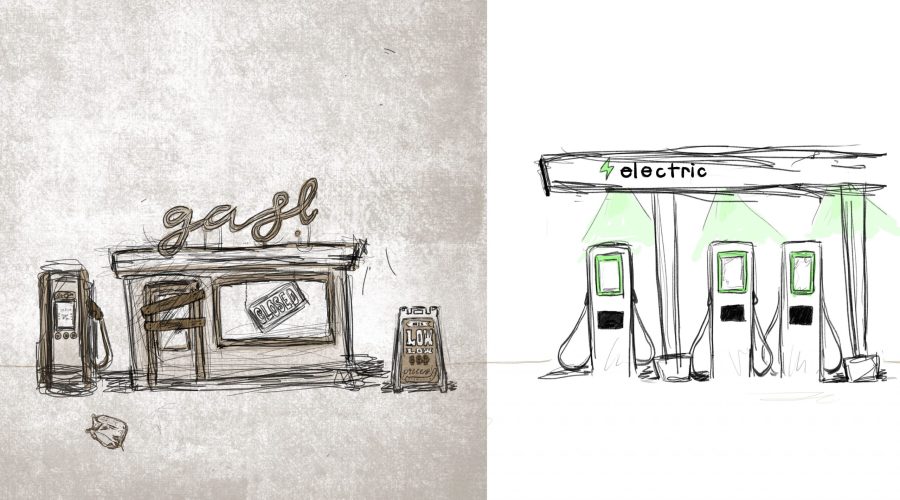Some 13.8 billion gallons of gasoline were sold in California in 2021, according to the California Department of Tax and Fee Administration. But a new decision on Aug. 25 to ban the sale of gasoline-powered cars in California by 2035 plans to significantly reduce this number.
The ban, issued by the California Air Resources Board and awaiting required approval from the Environmental Protection Agency, will prohibit the sale of cars that emit greenhouse gasses like carbon dioxide, accelerating the transition to electric vehicles in California. The rule also sets intermittent targets: 35% of cars sold by 2026 and 68% of cars by 2030 must produce zero emissions. Today, only 16% of new cars reach this threshold.
While eliminating gas-powered passenger vehicles would be monumental in combating climate change, increased accessibility and availability of electric cars, substantial infrastructure, and a more gradual implementation of eco-friendly vehicles is necessary to ensure success.
When buying an electric car today, your options are limited compared to gas cars. Unless you’d like to be associated with Elon Musk – the billionaire who fires people for disagreeing with him while also criticizing Twitter’s moderation policies for infringing on free speech – by driving a Tesla, your options are a small range of spaceship looking, low-power models.
This lack of options raises concerns because many people drive for reasons more than just to get from Point A to Point B. They view their car as a form of self-expression and even a companion.
While Ford became the first American car brand to introduce an all-electric truck this year, and other car companies plan to follow suit with more powerful and utilitarian electric cars, they are far from comparable to their gas counterparts. Ford’s electric F-150 is over $17,000 more than the gas version, and the range is only 230 miles for the electric model compared to 700 miles for the gas model. While not having to pay for gas may reverse the increased cost of the car itself, many people can’t afford the increased cost of an electric car and thus will be hesitant to purchase one.
In addition, most electric car models on the market are high-end cars, meaning they are expensive, electric or not. To make electric cars a comparable alternative to gas cars, car companies should convert lower-end models to electric power first to provide the same, more affordable options that the market for gas-powered cars offers.
While many car brands like Nissan and Chevrolet have added electric car models to their lineup, few besides Ford have converted existing gas models to electric ones. Not only does converting existing, less expensive models to electric help increase accessibility, but it also makes it more likely that gas car owners will make the switch to electric since it’s still the same model they’re used to.
Not only is there a lack of affordable electric vehicles, but their shorter ranges are inconvenient because electric charging stations are not as available as gas stations.
While charging stations are common across the Bay Area, there are often few in low-income areas. What’s more, depending on the electric vehicle, charging times can range from 30 minutes to 12 hours, making stopping for power bothersome and a luxury most cannot afford.
Furthermore, other states will have to get on board with all-electric vehicles soon to allow car companies to expand the affordability and range of their electric vehicles. If surrounding states continue to sell gas cars, it will be difficult for car companies to allocate the necessary resources to go all-in with electric vehicles and meet the requirements of the ban by 2035.
The ban also ignores the fact that not all motor vehicles will be able to make the transition to pure-electric by 2035. Though electric construction trucks would be ideal, there are likely many inhibiting factors including the sheer size and weight of trucks. With gas stations closed due to a lack of demand, the government will have to provide larger, diesel powered vehicles alternative methods to continue acquiring fuel.
In addition, banning the production and sale of all cars that rely even partially on gas, including hybrid vehicles, may make it harder for people to transition to electric vehicles.
For many car owners, a hybrid car serves as a gateway to getting an electric car because it offers many of the same features as a gas car while introducing some of the sensation and style of an electric car.
And while hybrid cars still produce carbon dioxide emissions, they tend to be more environmentally friendly and fuel efficient than gas cars. Therefore, the California Air Resources Board should consider allowing a certain percentage of hybrid vehicles past 2035 to help ease the transition to fully electric vehicles and focus on making smaller, more effective changes.
If nothing else, gas stations are a part of American culture that many will be sad to let go. With increased accessibility of electric cars, the right infrastructure and a more gradual rollout, get ready to say your goodbyes to your favorite gas station snacks and dingy bathrooms come 2035.

